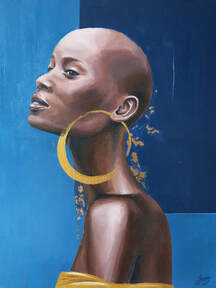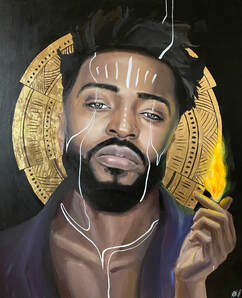International experience across countries and people has helped Russian artist Margarita Howis dissolve borders and question the traditional notion of home, while shaping the sense of unity and building a strong conviction of sustainability demands both environmentally and socially. Her work is influenced by observing cultural differences and perspectives on authenticity. |
an interview by Carmen Line Hust
Margarita Howis is a creative rebel and an artist by heart with a background in architecture. A world citizen, Margarita lived in 7 countries across the world, from Europe to China, and became a staunch cosmopolitan. International experience across countries and people has helped her dissolve borders and question the traditional notion of home, while shaping the sense of unity and building a strong conviction of sustainability demands both environmentally and socially. Her work is influenced by observing cultural differences and perspectives on authenticity. Through her experiences she has come to understand the ways in which culture shapes our understanding of ourselves and our place in the world. Through her work, she explores the themes of identity, localization, cultural differences and climate preservation. The artist's desire is to capture the true essence of unique places and cultures, to portray the unique characteristics and qualities that define each location, rather than presenting a generic or stereotypical image. She explores the idea that every place has its own unique identity and that this identity should be celebrated and protected. Climate preservation is a central theme in her work, as she is deeply concerned about the impact of climate change on the planet and its inhabitants. Additionally, she is interested in the ways in which cultures vary and interact with one another, she aims to highlight the richness and diversity of the world's cultures, and to promote the understanding and appreciation of different ways of life. Margarita is confident in her purpose of making a positive contribution to the world with her Colors for Climate project. The project aims to create action around climate change and the environment by using artwork to reach out and touch both the hearts and minds of people all over the world. As the saying goes, a picture does say more than a thousand words, and we have been speaking about climate change for way too long. One that can take the greatest and most abstract challenges of our time, such as wildlife conservation and climate change, and translate it into something personal and meaningful to every human being. She is on a mission to combat climate fatigue using art as the primary weapon. From where is your drive generated, in regards to your artistic work?
Experiences across different countries and people has made me into a proud cosmopolitan by shaping my sense of unity and strengthening my conviction of the need for sustainability - all in all greatly influencing my art. In my work I am passionate about themes of identity, cultural differences, and climate preservation. I aim to capture the essence of unique places and cultures, showcasing their individual qualities rather than relying on stereotypes. I believe that every place has its own identity, and it is important to celebrate and protect it. The impact of climate change on our planet and its inhabitants is a major concern of mine, and I reflect this in my work. I am also intrigued by the variations and interactions of cultures and strive to highlight the diversity and richness of the world's cultural heritage, promoting the understanding and appreciation of different lifestyles. For example, my Colors for Climate project seeks to raise awareness and inspire action on the issue of climate change. The project uses artwork as a tool to reach the hearts and minds of people globally, with the belief that a picture can say more than a thousand words. The project consists of a series of abstract landscape paintings and portraits that depict communities and places that are on the front-line of climate change. The landscapes showcase natural wonders that are either being impacted by climate change or human intervention, while the portraits showcase ethnic cultures and indigenous tribes that are threatened by a changing climate. Through these paintings, the project seeks to bring attention to the reality of climate change and make it relatable and personal, instead of abstract and distant. The project's goal is to raise awareness about the importance of preserving our planet, and to promote a deeper care for the environment and respect for nature and cultures. My hope is to ignite a spark in people and inspire them to see the world from a different angle. And inspire people to be more open to different cultures and to see the beauty in their differences in a relatable and personal way. How did you develop your artistic vocabulary?
As an artist behind the Colors for Climate project, my artistic vocabulary developed through a process of experimentation and self-discovery. I experimented with different styles, mediums, and techniques to find what resonated the most with me and what conveyed my message best. This process also allowed me to get to know myself better as an artist and understand my own unique voice and vision. It was through this process of exploration and reflection that I was able to refine my artistic vocabulary and develop a style that was authentic to me. One cannot skip these steps in the process of developing an artistic vocabulary. The process of experimentation and self-discovery is crucial in understanding what techniques and styles best convey one's message and in establishing a unique voice. It is through these steps that an artist can create work that is meaningful and impactful. Do you work with a project-minded approach, or does the themes of your work evolve in a more dynamic way?
As a professional artist, I believe it is important to have a project-minded approach. It helps to focus on a specific goal and message and allows me to fully explore and develop the theme in a more organized and effective manner. Having a project-minded approach also sets me apart from hobby artists, as it implies research, planning, and execution. It helps me stay focused and avoid getting lost in creativity without direction. It allows me to experiment and push boundaries while still having a clear purpose and outcome in mind. Overall, I believe that a project-minded approach is essential for professional artists who want to make a lasting impact with their work. For example, on the Colors for Climate project, my focus is on creating art that raises awareness about the impact of climate change and inspires action to protect our planet. The themes of my work are centered around this goal, and I approach each piece with the intention of bringing attention to a specific aspect of the issue. I believe in the power of art to evoke emotions and make a lasting impact, and I work diligently to ensure that each piece in the series effectively communicates the message I want to convey. However, I am open to allowing the creative process to unfold in a dynamic way and am always experimenting with new techniques and approaches to make my art as impactful as possible. What is your preferred media and why?
After taking in the Scandinavian lifestyle through a lens of an architect, my inspiration has come to draw upon the Danish design philosophy of minimalism and simplicity. As a painter, I combine realism with experimental abstract motives. Being adventurous and inventive, I seek to introduce a range of different mediums to my canvas, from painting with a traditional brush in acrylic, to fluid art, and even plate paintings with sustainably sourced 23K gold and silver. If your works are pre-thought, how do the idea emerge and how do you select which ideas proceed, and which not?
I believe in having a project-minded approach. The themes of my work are pre-thought and emerge from careful research, deep reflection, and a desire to create meaningful impact through my art. I select ideas that align with my mission. I consider factors such as how well the idea can be translated into a visually stunning work of art, how effectively it can communicate my message, and how unique it is compared to other works in the field. Ultimately, I proceed with ideas that I feel passionate about and that I believe will have the most impact in spreading my message. What do you believe is a key element in creating a good composition?
I believe that a key element in creating a good composition is balance. When I teach abstract art, I always emphasize that composition is the key to express and communicate the idea. The elements such as rhythm, proportions, scale, color and texture weight should be harmoniously balanced within the composition to evoke a visual interest and a cohesive look. Proportions - not just between elements - but in relation to the canvas, as well as considering the relationship between the positive and negative space, contribute to the whole appearance. Effective use of color can greatly enhance the composition, while thoughtful placement of the subject matter can lead the viewer's eye through the piece. And even though there are ways to achieve a balanced composition, for instance by following the rule of thirds or the golden ratio, creating a good composition requires a strong sense of design and an understanding of the elements of art. If you should mention an artist(s) that influence your work/draws your attention, who would it be and why?
Harif Guzman, Yulia Bas, Ruben Carrasco, Rio Artiste have been an inspiration for me, not only in terms of their artistic ability to convey emotion in their paintings, but most importantly their exploration of own identity and unapologetic expression of their views. Their work and artistic journeys have inspired me to explore my own experiences and perspectives as an artist. I also find Misha Liberty, Tahlia Stanton and Kim Rose very inspiring in terms of how they have managed to build up the brand and hype their artwork in non-traditional matter. What I learned from them is that it takes so much more than just being able to create great art to stand out of from the crowd and grab people’s attention. When people buy a particular piece of art, it is just as much based on how they admire and connect with the artist in addition to how they connect with the particular piece of art. This article about Margarita Howis is part of the ARTICULATE PROMOTE PROGRAMME.
|
SUPPORTARTICULATE
www.articulate.nu SUPPORT Monday - Friday 8:00 - 16:00 [email protected] +45 30 48 19 81 Head Quarters VAT DK40953191 |
|












